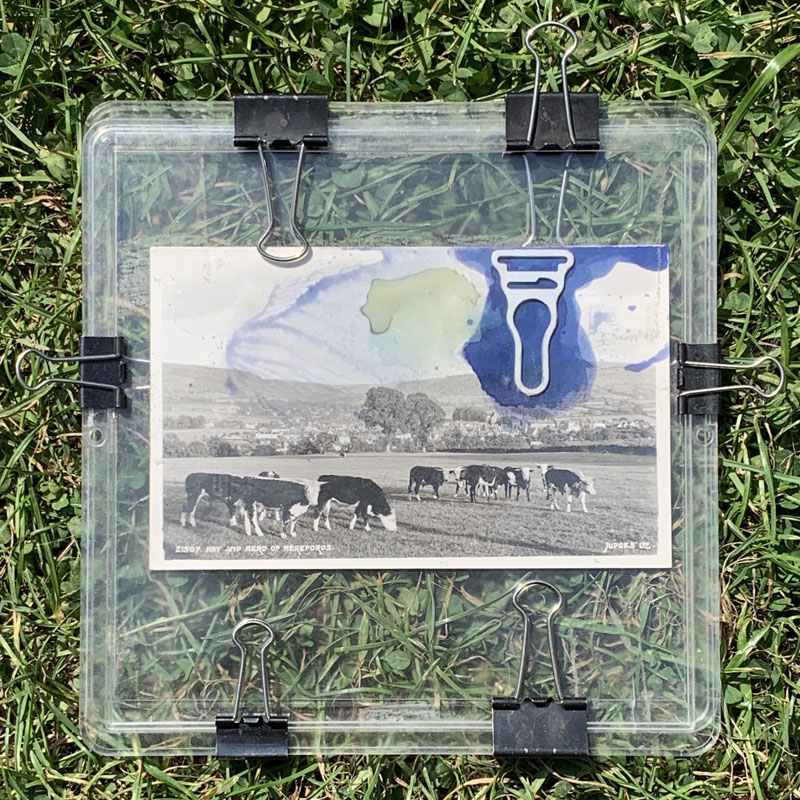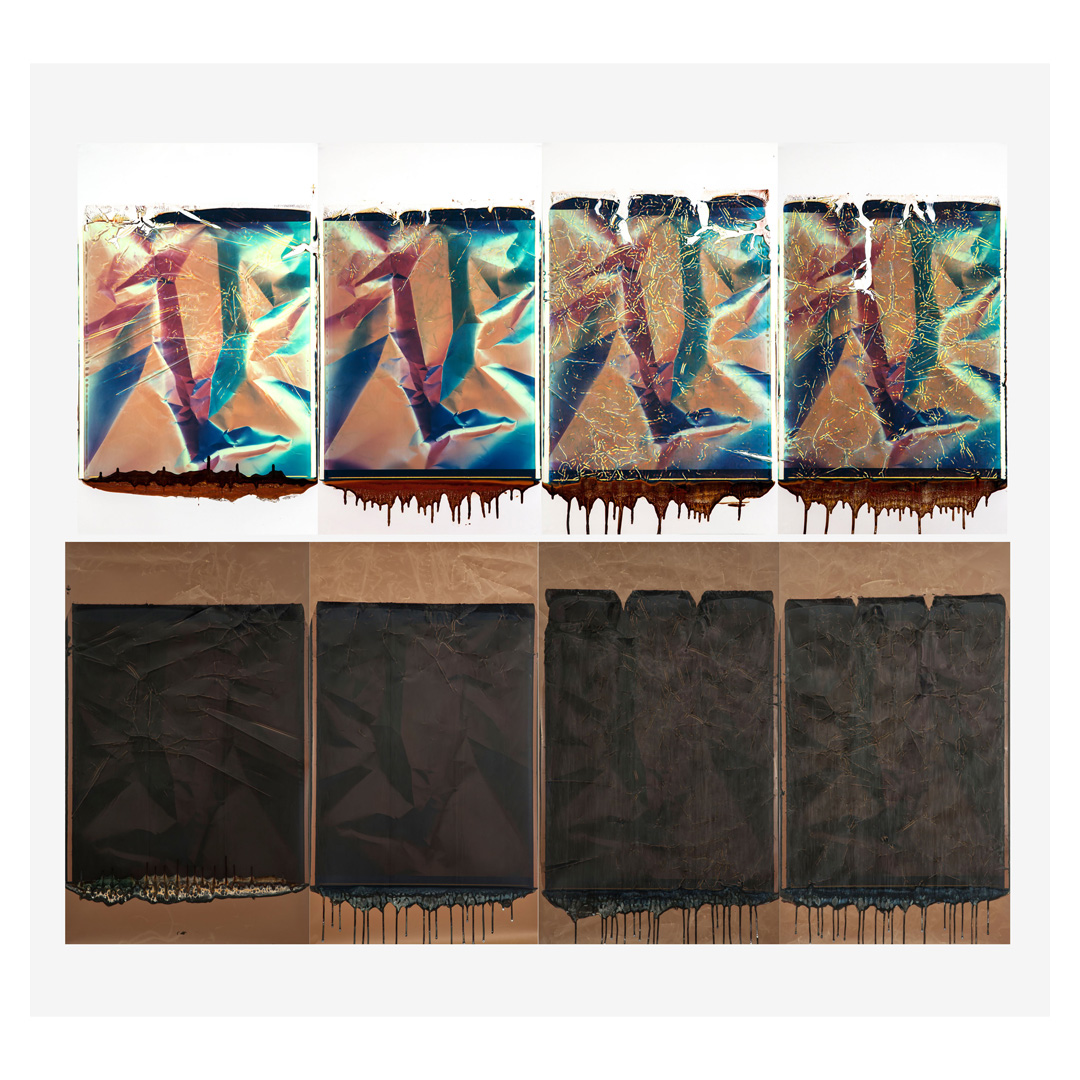
Grave Goods, Anthotype print in progress: suspender hook on postcard of Herefordshire Cattle at Hay on Wye. from the Personal Possessions of Eileen Jones (nee Cooke) 1940 – 2017 © Nettie Edwards
Congratulations to Nettie Edwards for her winning series Grave Goods. “All your submissions were incredible.. …. and special congratulations to Nettie Edwards, [… whose] work recounts HERstory, in a distinct approach.” (Ellen Carey)

An open letter from Ellen Carey
Dear HH Experimental Women Photographers
Light’s immateriality challenges its makers today, analog versus digital, doubles our challenges. “What is a 21st century photograph?” … and … “What does a 21st century photograph look like?” It is here, in the early stages of modern and contemporary art with its roots in photography, that your work has context.
At the dawn of photography, one finds the photogram (1834). The word “photography” literally means “drawing with light” from its Greek roots; phōs for light, graphis for drawing. Originally called “photogenic drawing” later the “photogram” a term that continues today. It was discovered by the British inventor, William Henry Fox Talbot (1800-1877) as a paper negative print (1834), contact printed for its positive (1840). The photogram legacy continues under my darkroom practice Struck by Light (1992-2020). In colour, this history begins with Victorian Anna Atkins (1799-1871), Talbot’s contemporary. She was the first woman practitioner, also camera-less and the first woman in colour through the cyanotype, “sun pictures” creating a Prussian blue, that had been taught to her by Sir John Herschel, its inventor, a friend to both.
Her photo-book pre-dates Talbot, and for good measure – guess what?- her written words under her botanical specimens, pointed to the future in: “word art”, so, yes, she was a pioneer, but added to the transformative power of colour embedded in her “light drawings” one sees – line-as-open in: abstraction and minimalism, size and scale, edge tension, chaos and order, symmetry and asymmetry, well of course, I can go on … and … on … and … on … so can you!
Thank you for the time and effort in our first global Hundred Heroines open call for experimental women photographers, our 21st century version of “The Linked Ring” — well we know what being female and a photographer looks like! Hey, let us ask all the women from the 19th century to the present to come forward! Their legacies, their labours, visual intelligences, life stories and incredible images shine forth … Keep up the good work … all your submissions were incredible.. …. and special congratulations to Nettie Edwards whom I look forward to exhibiting alongside in London in October 2020.
Grave Goods by Nettie Edwards explores love and loss which are universal themes, intertwined like DNA, echo and mirror, and in photography, characteristics of the medium are visually seen in – outline, silhouette, negative — the “shadow” image, an absence of light … light’s first traces, its prima facie…first face of life; standing opposite its twin, the positive.
Nettie’s work recounts HERstory, in a distinct approach, in her series — Grave Goods — both a record and document, a family snapshot, if you will. She highlights the story of the “shadow” as a memento mori, in a photographic tableaux and homage to a loved one, who recently passed away. Her visual diary, underscores the “shadow” in art and photography, adding context, while content is seen through her experimental tableau vivant — here, in her work, I am reminded of the Greek fable as told by Pliny the Elder:
“Pliny the Elder, in his Natural History (ca. 77 – 79 CE), relates the myth of art’s origin in a fable about the daughter of Butades, a Greek potter from Corinth. She drew the outlined profile of her lover’s shadow as it was projected on the wall by a lamp, just before he left for battle, and which her father made into a sculptural relief. Thus, before the real shadow departs with its owner it offers the young woman an image with which to represent her beloved — that which she fixes on the wall for all time [1].
According to art historian, Victor I. Stoichita, in his remarkable book, A Short History of the Shadow (1997) [2], the hidden meaning of this myth involves the transcendence of death. The image of the lover’s face on the wall is a vertical, erect, life-like projection, a figure.
What is the daughter’s intent? To memorialize him?, Give him life?, Induce a phantasm of foreplay when besieged so by the throes of Eros and Thanatos? We simply do not know. She seems to vanquish the threat of his death in war by making an image that literally stands in for his absence — she makes him upright, that is, forever alive. Although the image she traced is only a spectre, it is, nonetheless, the immaterial counterpart or double of the absent lover.
It is not lost on us here in the 21st century that Butades’ daughter is nameless — a namelessness standing in for the fact of women’s absence throughout art history, and a marker of women’s invisibility in language that ignores this one fact: the need to name the world is a human need. Nevertheless the daughter’s image remains. It is timeless.” (Donna Fleischer, 2014) [3]
Until next time, keep submitting…
Yours, from over the pond!
Ellen
www.ellencareyphotography.com
References
[1] Painting (2 shadows), p. 38 & photograph (1 shadow), p. 39 in Sun Pictures Catalogue Thirteen: A Twentieth Anniversary Selection by Hans P. Kraus, Jr., with text by Larry J. Schaaf (New York: Hans P. Kraus, Jr. Fine Photographs, 2004), 38 – 39.
[2] Victor I. Stoichita, A Short History of the Shadow, (London: Reaktion Books Ltd., 1997), 15 – 20.
[3] Donna Fleischer, “The Black Swans of Ellen Carey: Of Necessary Poetic Realities” essay accompanying the one-person exhibit Let Their Be Light:The Black Swans of Ellen Carey at Akus Gallery, Eastern Connecticut State University (ECSU), January-February 2014.
The shortlist can be found here

Crush & Ding (2019) © Ellen Carey










